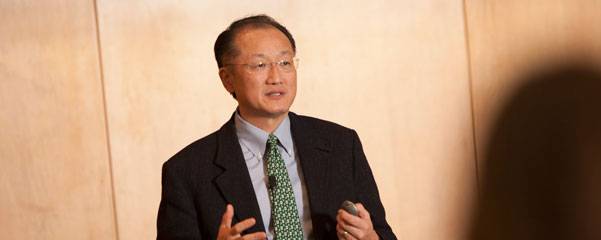Jim Yong Kim Launches $300 House Design Workshop
Jim Yong Kim urges teams, including Tuck School students, to ignore aid industry cynics.

You can find them in the bars of big hotels in the capital cities of the world’s poorest countries. From Port au Prince to Kigali, jaded aid workers from across the rich world sit on barstools, ready to dismiss new ideas for improving the lives of the poor as unworkable or naïve.
That was the warning from Dartmouth President Jim Yong Kim to a group of Tuck School of Business students, engineers, and designers who gathered at the Georgipoulos Classroom in Tuck’s Raether Hall January 25 for the start of a four-day workshop to implement Tuck professor Vijay Govindarajan’s challenge to design a $300 house for the world’s poor.
“The narrative goes something like this: These people are poor because they deserve to be poor, every effort I’ve made to lift them out of poverty has failed,” said Kim, in his keynote address launching the $300 house design workshop. “Who the hell are you to come and tell us that something we know to be is impossible is possible.”
The stew of charities, for-profit contractors, and donors that comprise the modern foreign aid industry can be no less bureaucratic, territorial, and inflexible than the largest corporations. Innovation requires the determination to go against the crowd.
Govindarajan, the Earl C. Daum 1924 Professor of International Business, and co-author Christian Sarkar’s 2010 Harvard Business Review blog post challenging the corporate world to design a $300 house that could provide clean water, shelter, and solar electricity to the world’s poorest has generated a spectacular response. The Economist, CNN, and The Guardian all published laudatory stories of the project while two critics of the contest were featured on The New York Times editorial page. A social networking site for the project now has 2,500 members.
The workshop brings together students, designers, planners, engineers, health care providers, business thinkers, and members of two communities in Haiti to develop design prototypes that will provide low-cost housing for those currently served by conventional housing programs. The plan is for work on the prototypes to continue beyond the workshop and eventually develop into pilot projects in Haiti.
Kim is well positioned to speak on the challenges of aiding the poor. As a Harvard medical student in the 1980s, he co-founded Partners in Health, an aid agency that now has more than 11,000 staff across the globe from Siberia to Lesotho.
The application of management practices to aid work is badly needed, said Kim. When businesses execute poorly, they’re eventually driven out of the market. Not so in the social sector. So long as non-governmental agencies can continue raising money they can continue operating.
For decades aid work was judged in moral terms, whereby agencies could declare success simply in demonstrating that they cared about the poor and were making an effort to help them. “When it comes to our most cherished social goals, we cherish executing poorly, we celebrate not knowing what our budget is or what our outcomes are,” said Kim. “I would argue that if you’re really, really committed you hold yourself to a very high standard of execution and outcome.”
In comparison to the private sector, aid groups also do a poor job of exchanging information about how to work more effectively. “The little tricks that airline companies know to be more effective are published everywhere,” said Kim. “The little tricks to deliver medicine to poor people more effectively aren’t shared anywhere.”
The design of the $300 house won’t prove a magic bullet in and of itself, Kim said. The key is in how the innovation can be delivered to ensure the best outcomes for the poor. Eradication of a disease that affected 50 million people each year in the 1950s came about not only because of the development of the smallpox vaccine, but because of enormously successful management of an eradication program that focused on targeted vaccinations of those most likely to have come in contact with the disease, he added.
As in business, listening to your consumers—in this case the world’s poorest—is key to a winning strategy. Years ago aid agencies attempted to introduce solar bread ovens. The only problem: many of the people it was designed for didn’t like bread. “People who were starving would come to us and say we can’t eat this,” said Kim. “A preferential option for the poor is very different from a preferential option for your idea.”
The housing project can succeed if those working on it can adopt ideas from their consumers while ignoring doubts from the aid establishment vested in the status quo.
“You’ve got to believe not only that it’s doable,” said Kim, “but you have to do it in the face all of all those people sitting in hotel bars in poor countries telling you its impossible because if it was possible they’d have already done it.”